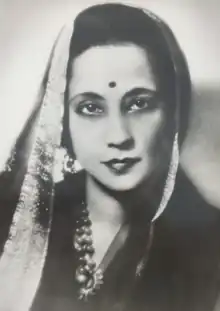Madame Menaka
Madame Menaka (October 15, 1899 – May 30, 1947) was the professional name of Leila Roy, Lady Sokhey, an Indian dancer and choreographer in the Kathak tradition.
Madame Menaka | |
|---|---|
 Menaka (Leila Sokhey), from a 1938 publication | |
| Born | Leila Roy October 15, 1899 Barisal, East Bengal |
| Died | May 30, 1947 |
| Other names | Leila Sokhey |
| Occupation | Dancer |
| Spouse | Sahib Singh Sokhey |
Early life and education
Leila Roy was born in Barisal, Bengal Presidency, the daughter of Pyare Lal Roy and Lolita Roy. Her father was a Bengali lawyer trained in England, and her mother was British.[1] She attended the Loreto Convent in Darjeeling and St Paul’s School in London.[2] She trained as a violinist in England, but pursued dance as a career, with encouragement from Russian ballet dancer Anna Pavlova, whom she met in London in 1927.[1][3] Her Kathak dance teachers included Pandit Sitaram Prasad and Achhan Maharaj.[4]
Career
Sokhey gave dance recitals in Bombay in 1928,[5][6] and began choreographing and teaching dance to students at the Haffkine Institute. She danced in Paris in 1930,[7] and her Menaka dance company toured Europe from 1935 to 1938.[8] They entered the Berlin Dance Olympiad,[9] in conjunction with the Summer Olympics in Berlin in 1936, and won several trophies.[10] She met modern dancer Mary Wigman during her time in Germany.[4][11] Her company and choreography appeared in at least two European films, the German-language Der Tiger von Eschnapur (1938) and a British documentary in color, Temples of India (1938).
In 1941, with her husband's financial support,[12] Menaka opened a residential school outside Bombay in Khandala,[13] named Nrityalayam.[14][15] One of her students was her adopted daughter, dancer Damayanti Joshi,[16] who later published a book of photographs and memories of Menaka.[17]
Personal life
Leila Roy married Sahib Singh Sokhey, a biochemist.[18] Their large home at the Haffkine Institute in Parel included her dance studio and was frequently host to visiting scientists and artists.[12][14][19] "Imperious, unconventional, sympathetic, big-hearted, she charms all with her intelligence and understanding," wrote a contemporary. "Her artificialities of vivid make-up and finery in dress are superficial and skin-deep, so to speak; she is, at heart, genuinely natural and simple."[20] Following her husband's knighthood in 1946, she became Lady Sokhey. She died from Bright's disease in 1947, aged 47 years.[21][22] The University of Mumbai awards a Menaka Trophy for excellence in Kathak dance.
References
- "Culture: Giants Who Reawakened Indian Dance". Hinduism Today. 2011-04-01. Retrieved 2021-11-24.
- Kabadi Waman P. (1937). Indian Whos Who 1937-38. p. 743 – via Newspapers.com.
- Khokar, Ashish Mohan (8 February 2011). "The Dance History Column: The role and contribution of pioneering gurus and foreigners in the revival of classical Indian dances (1900s-50s)". Narthaki. Retrieved 2021-11-24.
- Kothari, Sunil (2019-11-11). "The magnetic Madame Menaka and the Tiger of Hastinapur". The Asian Age. Retrieved 2021-11-24.
- "Indian Art Revival: 'Menakas Programme at Excelsior". The Bombay Chronicle. 29 December 1928. p. 15. Retrieved November 24, 2021 – via Internet Archive.
- Vakil, Kanaiyalal H. (February 1928). "Dancing in India: A New Era". The Modern Review: 689–692 – via Internet Archive.
- "Foreign show News: Indian Dancers are 1 Too Many in Paris" Variety 100 (20) (Nov 26, 1930): 55. ProQuest
- "Indian Dancers' Triumphs Abroad; Menaka Troupe's Success in the Capitals of Europe". The Bombay Chronicle. 22 April 1938. Retrieved November 24, 2021 – via Internet Archive.
- Khokar, Ashish (2018-05-31). "Menaka, Mrinalini and Maya, the dancing trendsetters". The Hindu. ISSN 0971-751X. Retrieved 2021-11-24.
- "Menaka at the Dance Olympiad". The Bombay Chronicle. 8 September 1936. p. 5. Retrieved November 24, 2021 – via Internet Archive.
- Warren, Vincent (2006). "Yearning for the Spiritual Ideal: The Influence of India on Western Dance 1626-2003". Dance Research Journal. 38 (1/2): 97–114. doi:10.1017/S0149767700007403. ISSN 0149-7677. JSTOR 20444666. S2CID 193774298.
- Palit, Maj Gen DK (2004). Musings & Memories: Vol (I). Lancer Publishers. p. 170. ISBN 978-81-7062-275-8.
- Swaminathan, Chitra (2018-05-17). "Madame Menaka choreography movement to highlight process of visualisation". The Hindu. ISSN 0971-751X. Retrieved 2021-11-24.
- Ganapathi, K. "Sahib Singh Sokhey 1887–1971" Indian National Science Academy Biographical Memoirs: 148-149.
- Walker, Margaret E. (2016). India's Kathak dance in historical perspective. London: Routledge. p. 119. ISBN 978-1-315-58832-2. OCLC 952729440.
- "Damayanti Joshi". Sruti Magazine. 2018-12-05. Retrieved 2021-11-24.
- Joshi, Damayanti (1989). Madame Menaka. Sangeet Natak Akademi.
- "Sahib Singh Sokhey (1887-1971)". The University of Edinburgh. Retrieved 2021-11-24.
- Shah, D. C. (May 17, 1933). "Interview with Menaka; True Art Must Transcend Technique". The Bombay Chronicle. p. 11. Retrieved November 24, 2021 – via Internet Archive.
- Venkatachalam, G. Dance In India. Bombay: Nalanda Publications. pp. 35–39, quote on p. 37 – via Internet Archive.
- Katrak, K. (2011-07-26). Contemporary Indian Dance: New Creative Choreography in India and the Diaspora. Springer. p. 36. ISBN 978-0-230-32180-9.
- "Menaka, the Pioneer". The Bombay Chronicle. 2 June 1947. p. 4. Retrieved November 24, 2021 – via Newspapers.com.
External links
- The Indian Ballet Menaka in Europe 1936-38, a website and database covering Menaka's company's European tour, including news accounts, ephemera, photos, and rare film clips
- Cinema Nritya, a dance scholar's blog that featured long, well-sourced and illustrated essays on Madame Menaka
- Saraswat, Shweta. "Constructing Diasporic Identity Through Kathak Dance: Flexibility, Fixity, and Nationality in London and Los Angeles" (Ph.D. dissertation, University of California, Los Angeles, 2019): 45-46, 108-110